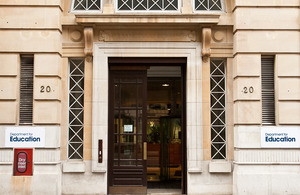New 3D printers to boost STEM and design teaching
A 3D printer programme that will boost science, technology, engineering, maths, and design and technology teaching is to be extended.

A programme to bring futuristic 3D printers into state-school classrooms to boost the teaching of science, technology, engineering, maths (STEM), and design and technology is to be extended by Education Secretary Michael Gove.
3D printing is already an established industrial technology used for prototyping and manufacturing products and components across a range of industries.
But it is a new concept in schools and last year the Department for Education funded a project to allow 21 secondaries to trial the use of the printers in STEM and design and technology classes.
Following the success of that trial, Michael Gove is bringing the technology into more schools - setting up a £500,000 fund so up to 60 teaching schools can buy 3D printers and train teachers to use them effectively.
It is the latest stage in the government’s programme to improve standards in hi-tech subjects. The new curriculum for computing will ensure primary school pupils learn to write computer programs while computer science will also be included in the EBacc from next year. The new design and technology curriculum, backed by inventor Sir James Dyson, specifically mentions 3D printers and will see pupils taught about advanced skills, including robotics, so that more are prepared for jobs in the engineering industry.
Michael Gove said:
3D printers are revolutionising manufacturing and it is vital that we start teaching the theory and practice in our schools. Teaching schools will be able to develop and spread effective methods to do this. Combined with our introduction of a computer science curriculum and teacher training, this will help our schools give pupils valuable skills.
The extension of the 3D printer programme follows the success of trials in 21 schools which used them in lessons.
A report into the pilot said that so far in the UK, the technology had been restricted largely to design and technology classes but that there was “considerable potential for them to be used within a range of STEM subjects, for example to enable links to be made between mathematics, design and physics in a similar way to, for example, ‘sound’ enabling links between music, physics (wave properties), biology (hearing) and engineering (concert hall design).”
The pilot schools reported that early work with the printer was often limited to demonstrations and printing of small files such as 3D shapes. This highlighted the need for good training of teachers, which is why part of the money will be for continuing professional development (CPD).
Examples of how the printers were used included:
- science departments used the 3D printer as a context to discuss the properties of plastics, to build models for teaching science such as molecules, eyeballs, cells and sine waves, and to build components for working equipment such as rockets
- at Watford Grammar School for Boys the printer was used to demonstrate a 3D graph for various algebraic equations as well as producing examples of regular shapes (dodecahedron)
- Honywood Community Science School in Essex designed an advanced 3D development learning tool, enabling pupils to create 3D objects using typed code in POV-Ray3. This enabled pupils to practise writing and debugging code and also supported studying algebra and understanding 3D/2D space
David Jermy, the head of design and technology at Settlebeck High School, in Sedbergh, Cumbria, said:
All the pupils who have been involved with the 3D printer so far have been inspired by its possibilities. The opportunity to realise a concept or idea quickly into a 3D product is an incredibly powerful teaching tool.
James Brady, head of technology at Simon Langton Girls’ Grammar School, in Canterbury, Kent, said:
With the printer carrying out the ‘production’ of objects, more time can be spent considering the science and mathematics involved in design. One pupil stated that the 3D printer had heightened her interest in mathematics and improved her desire to learn. Subsequently she commented that it improved her level of achievement.
Notes to editors
The funding covers the rest of this academic year and 2014 to 2015.
DfE media enquiries
Central newsdesk - for journalists 020 7783 8300